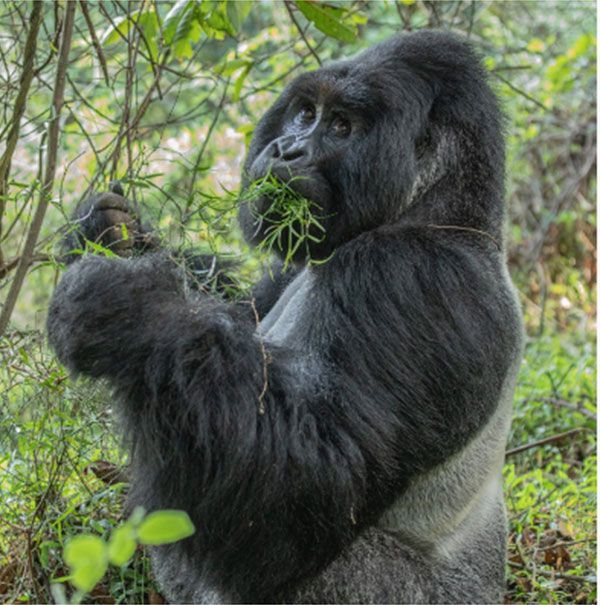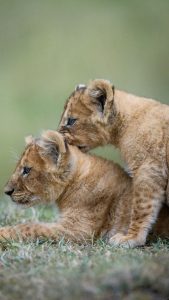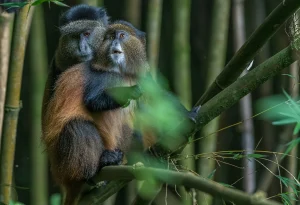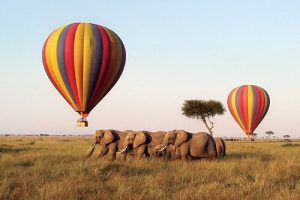Mountain gorillas are among the planet’s most majestic and endangered creatures. Their survival is a testament to dedicated conservation efforts, with gorilla tourism emerging as both a powerful tool and a complex challenge. This symbiotic relationship between humans and gorillas is a delicate balance, providing significant benefits while also introducing potential risks. Understanding this dynamic is crucial for responsible travel and effective conservation. Gorilla Tourism Benefits and Challenges.
The Importance of Gorillas and Their Environmental Role
Gorillas are more than just a tourist attraction; they are a cornerstone of their ecosystems. As large herbivores, they play a vital role in maintaining the health of the rainforests they inhabit.
Forest Regeneration and Seed Dispersal: Gorillas consume vast quantities of fruit and vegetation. As they move through the forest, they disperse seeds through their waste, helping to regenerate and diversify the plant life.
Creating Forest Trails: Their immense size and strength mean they create trails and clearings as they navigate the dense undergrowth. These trails can be used by smaller animals, making it easier for them to move and access resources.
Indicator Species: The presence of a healthy gorilla population is a strong indicator of a thriving ecosystem. Their well-being reflects the overall health of the forest, making them a key focus for conservationists.
Economic Benefits of Gorilla Tourism and Conservation Funding
Gorilla tourism is a high-value, low-volume model that generates substantial revenue, which is directly linked to conservation and community development.
Economic Benefit in Virunga National Park: In Virunga National Park, located in the Democratic Republic of Congo, gorilla tourism is a major source of income. This revenue funds the park’s operations, including the salaries of over 700 rangers who protect the wildlife from poachers and armed militias. A portion of the park’s income is also invested in local communities through infrastructure projects, education, and job creation, which in turn reduces the incentive for locals to engage in illegal activities like poaching or charcoal production. The park’s success has demonstrated that wildlife conservation can be a powerful driver for regional economic stability.
Funding Conservation Efforts: Across the gorilla range, the high cost of a trekking permit is a direct investment in the gorillas’ future. This money pays for anti-poaching patrols, veterinary care, habitat protection, and research. Without this crucial funding stream, it would be nearly impossible to sustain the efforts that have led to the mountain gorilla’s population increase.
Challenges and Threats to Gorillas
Despite conservation successes, gorillas still face numerous, severe challenges.
Habitat Loss and Human Encroachment: This is the single greatest threat to gorillas. As human populations grow, forests are cleared for agriculture, logging, and human settlements. This fragmentation isolates gorilla groups, limits their access to food, and increases the risk of human-wildlife conflict.
Poaching: While direct poaching for meat or trophies is less common for mountain gorillas due to intensive protection, it remains a serious threat to other gorilla subspecies. Additionally, gorillas can be accidentally caught and killed in snares set for other animals like antelopes. The illegal pet trade also drives the poaching of infants, which often results in the death of the entire family group.
Disease Transmission: Gorillas and humans share a high percentage of their DNA (about 98%), making gorillas highly susceptible to human diseases. A common cold or flu, which is a minor ailment for a human, can be fatal to a gorilla. This risk is a major concern for both wild and habituated gorilla groups.
Potential Risks and Ethical Concerns of Gorilla Tourism
While tourism is a vital conservation tool, it is not without its risks.
Potential Risks of Gorilla Tourism:
The most significant risk is the transmission of disease from humans to gorillas. Even with strict rules in place—like maintaining a 7-meter distance and wearing masks—a gorilla could still be exposed to a pathogen. Stress from human presence and the potential for habituated gorillas to lose their fear of humans are also concerns.
Challenges Mountain Gorillas Face:
In addition to the broader threats, mountain gorillas face the unique challenge of having a very small, isolated population. This limited genetic diversity makes them more vulnerable to disease and inbreeding issues. They are also highly sensitive to climate change, which can alter the delicate ecosystems they depend on for food. Gorilla Tourism Benefits and Challenges.
Debunking Misconceptions and Addressing Unusual Questions
Some common questions about gorillas require clarification to provide a factual and accurate understanding of these animals.
Are gorillas good or bad?
Gorillas are wild animals, not moral agents. They are neither “good” nor “bad.” They are complex, social creatures that act on instinct and learned behaviors. Their immense strength and sometimes aggressive displays are a natural part of their social hierarchy and defense mechanisms. Gorilla Tourism Benefits and Challenges.
Why do gorillas help humans?
Gorillas do not actively help humans. They are wild animals that primarily interact with their own groups and the environment. While some have shown curiosity or a lack of aggression towards researchers, they are not naturally inclined to assist humans. The idea that they would help is a common misconception from popular culture. Gorilla Tourism Benefits and Challenges.
What are the benefits of “gorilla mind” or “gorilla exercise”?
These are likely misphrased questions or refer to commercial concepts, not biological ones.
Gorilla Mind: Gorillas possess remarkable cognitive abilities and a high degree of intelligence. They have complex social structures, use a variety of vocalizations and gestures to communicate, and can learn through observation. In captivity, some gorillas, like Koko, have famously learned to communicate using sign language, demonstrating their capacity for abstract thought and emotional expression. Gorilla Tourism Benefits and Challenges.
Gorilla Exercise: Gorillas are naturally incredibly strong and agile. Their daily activities—climbing, foraging, and traveling—provide all the exercise they need. There is no concept of “gorilla exercise” as a distinct benefit outside of their natural behavior. Gorilla Tourism Benefits and Challenges.
Key Facts and Special Abilities
Here are some quick facts and special abilities that highlight the uniqueness of gorillas.
5 Facts about Gorillas:
Gorillas build new nests every night from leaves and branches to sleep in.
The dominant male in a gorilla family is called a silverback because of the distinctive silver saddle of hair on his back.
Gorillas are herbivores and spend most of their day eating.
They are highly social animals that live in family groups called “troops.”
Gorillas are incredibly powerful but are generally gentle and shy unless threatened.
What special abilities do gorillas have? Gorillas have incredible strength, particularly in their upper bodies. A male silverback is estimated to be about six to eight times stronger than a human man. They also possess an excellent memory and can recognize individual members of their troop and other gorilla groups. Gorilla Tourism Benefits and Challenges.
Gorilla Trekking in East Africa
The high demand for this unique wildlife experience has created different pricing models across the region.
Why is gorilla trekking more expensive in Rwanda than Uganda?
The primary reason for the price difference is a conscious strategy by the Rwandan government to position itself as an exclusive, high-end tourism destination. Rwanda’s gorilla permit costs $1,500 per person, compared to Uganda’s $800. This higher price point is intended to attract a specific type of traveler, reduce the overall number of visitors, and generate more revenue per visitor, which is then reinvested into conservation. Gorilla Tourism Benefits and Challenges.
What two national parks in Uganda are famous for mountain gorillas?
Uganda is home to mountain gorillas in two national parks: Bwindi Impenetrable National Park and Mgahinga Gorilla National Park. Bwindi holds the largest population, while Mgahinga, part of the wider Virunga massif, is also home to a habituated group. Gorilla Tourism Benefits and Challenges.
The Role of Gorillas in Captivity
While the ideal is for gorillas to live in the wild, captivity, when managed ethically, can provide some benefits.
Positives of Gorillas in Captivity:
Zoos and conservation centers with well-managed programs contribute to species survival through breeding programs that maintain genetic diversity. They also play a crucial educational role, raising awareness about conservation and inspiring the public to support wild gorilla protection. Captivity allows for scientific research into gorilla health and behavior, which can be used to improve conservation efforts in the wild. Gorilla Tourism Benefits and Challenges.
In conclusion, gorilla tourism presents a compelling case study in conservation. By providing a powerful economic incentive to protect these magnificent animals, tourism has been instrumental in the mountain gorilla’s remarkable recovery. However, this success is fragile and requires constant vigilance to mitigate the risks of disease, habitat loss, and human-wildlife conflict.
The future of gorillas depends on a shared commitment to responsible tourism, community empowerment, and the unwavering dedication of conservationists on the ground.




